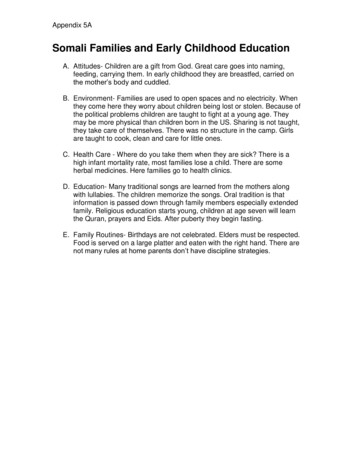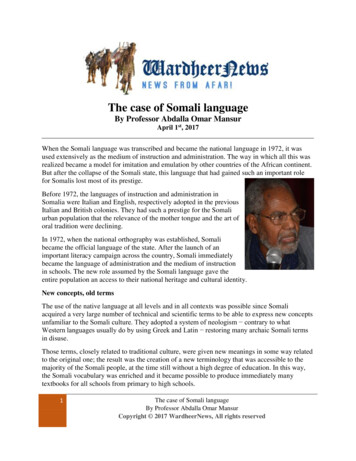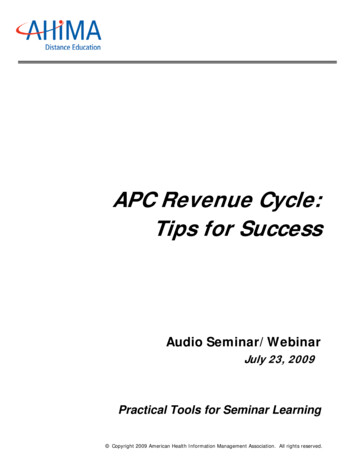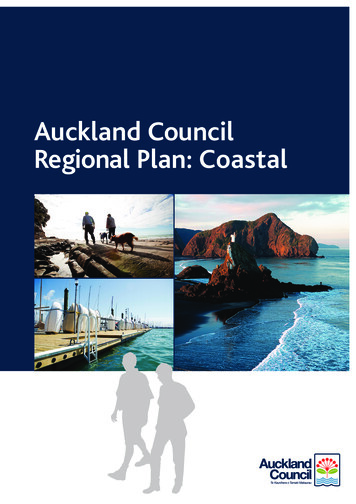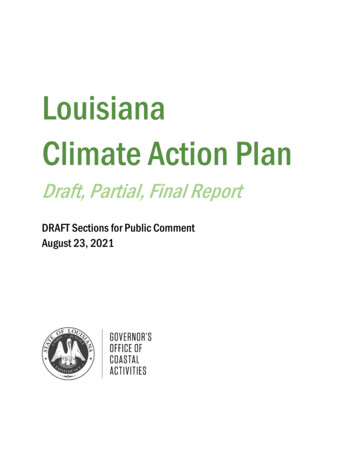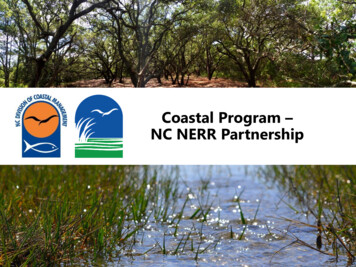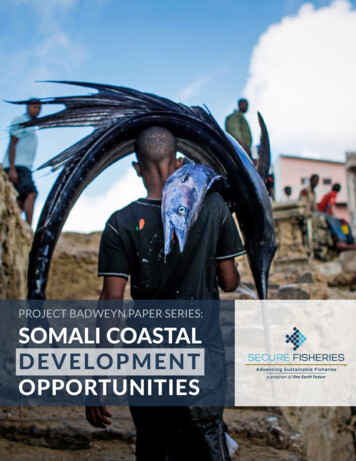
Transcription
PROJECT BADWEYN PAPER SERIES:SOMALI COASTALD E V ELOPM ENTOPPORTUNITIES
PROJECT BADWEYN PAPER SERIES:SOMALI COASTALDE V E LO P M EN TOPPORTUNITIESPaige M. RobertsAhmed-Yasin Osman MogeKaija J. HurlburtJuly 2018http://dx.doi.org/10.18289/OEF.2018.032 Copyright One Earth Future 2018. All rights reservedCover Image: A Somali fisher carries a sailfish to Mogadishu’s fish market. AU-UN IST Photo/Stuart PriceAll satellite images from Google Earth.
ACKNOWLEDGEMENTSThe authors would like to thank the Somali fishers, government officials,and international organization employees who provided information forour case studies. We appreciate the input provided by Sarah Glaser, LauraBurroughs, and Mahad Awale.Design & layout by Liz Allen, One Earth Future.
TABLE OF CONTENTSEXECUTIVE SUMMARY.ivI. INTRODUCTION.01Somali Development Plan Goals for the Fishing Sector . .02Methodology.04Case Study Locations.08Major Challenges Across All Case Study Locations.08CASE STUDIES:II. PUNTLAND.15Bereda.16Hordio.19Bander Beyla.22III. SOMALILAND. 26Maydh.27IV. HIRSHABELLE STATE. 31Hawaay.32V. SOUTH WEST STATE. 35Merca.36REFERENCES. 39
iv Somali Coastal Development OpportunitiesEXECUTIVE SUMMARYSomali fisheries offer great potential for growth to improve coastal livelihood security. The Federal Government of Somalia,regional governments, and the international community have prioritized coastal industries, especially fisheries, in theirplanned development efforts. Previous and current efforts have been predominantly concentrated in the most populatedcoastal cities, but there are many opportunities to create projects in underserved areas that will improve local food andeconomic security while delivering long-term benefits and positive returns on investment. This report outlines a sciencebased method for identifying favorable locations for fishing-sector investments. We use local knowledge of fisheries andsector needs to describe an approach to developing fisheries while maintaining the health and resilience of the resources toensure future economic security.In this report, we use fisheries landing site data derived from satellite imagery and overlay current international developmentprojects to identify locations where new developments could have a large impact. We focus on areas that, to date, have notreceived significant investment or development assistance but have access via a road. We chose six communities for furtherresearch on livelihoods and fisheries. We combined fish catch estimates, measures of their sustainability, and information onforeign fishing to create a fishing profile of each community.Our research finds that Somali fishing communities need: improvements to civic infrastructure like roads; expansion of fishing infrastructure like freezers, icemakers, and processing facilities;integration of women’s associations in trainings anddecision-making; better access to the ocean through jetties or docks;an expanded role for fishing cooperatives to build sectorstability; investment in skills like hygienic fish processing; markets for underutilized, sustainably fished products; a robust system for collecting, storing, and reportingcatch data; systems to identify and report illegal fishing; and education and management measures to divert efforttoward more sustainable fisheries.Looking out on Berbera harbor, Jean-Pierre Larroque
Somali Coastal Development Opportunities vOur case studies span multiple states in the Somali region and show that while the overarching needs of coastal communities aresimilar, there are different opportunities among locations based on the main catch in an area, regional differences in fisheriesmanagement and governance, and the local security situation. The case study locations and their primary opportunities fordevelopment are as follows.Bereda A jetty or dock to serve local fishers and traders comingfrom nearby countries Education about the ban on lobster fishing in Puntlandand why it is important to the future viability ofthe lobster fishery, and implementation of moresustainable fishing practicesHordio Installation of sources of reliable and renewableenergy for the community A market for sustainably caught sardines for humanconsumption or use in local farming as animal feed orfertilizerBander Beyla Implementation of a fish catch data collection systemin conjunction with the fishing cooperative, women’sassociation, and regional and federal governmentauthorities Education around identifying and reporting illegalfishingMaydh Improved fishing infrastructure and a paved roadbetween Maydh and the regional capital, Erigabo Encouraging a shift in fishing practices to target moresustainable but still lucrative species like jacks andtrevalliesHawaay Investment in freezers and processing facilities coupledwith facility maintenance trainings Education about hygienic fish processing including thesalting and drying of fishMerca Increased area security and improved civicinfrastructure to allow efficient transportation of fishproducts to nearby MogadishuOverall, this new approach to identifying Somali coastal development opportunities can guide international donors andprivate investors in order to ensure that future projects increase the resilience of Somali communities while maximizingproject impact.
01 Somali Coastal Development OpportunitiesI. INTRODUCTIONThe Somali coast has long been considered an area of opportunity for economic growth. Development plans from Somalifederal and regional governments identify expanding the fisheries sector as a major goal with the potential to improvefood and economic security in coastal communities. International aid groups have also turned their attention to fisheriesas a growing sector with significant investment potential. Both the government and development groups concentrate theirefforts in the most populated coastal areas. Our research highlights the potential to expand these efforts to other coastalcommunities that have similarly abundant fisheries resources and a fishing community but limited access to financial anddevelopment support.Current efforts to develop domestic fisheries along the Somali coast concentrate predominantly on the most populatedcoastal cities like Berbera, Bosasso, and Mogadishu. These locations draw international attention and support for manyreasons. First, higher population numbers mean investments will impact a greater number of recipients. Second, ease ofaccess is favorable, in terms of infrastructure, including major roads and airports, and security options that enable donorsand implementors to travel to and operate in these areas safely. Third, demand for fish is greater. International developmentprojects often have constricted budgets and timelines, so executing efforts where access is easy and where positive impactwill be large and most immediate is important for demonstrating return on investment.However, our research identifies opportunities to expand efforts to underserved communities that stand to realize significantgains from increased donor attention and support for their fishing sectors. Distributing fishing efforts along the coast andstrengthening the value chains in more remote areas can help fulfill market demand in the cities while avoiding depletion oflocal fish populations in the most heavily fished areas. This will also support a wider range of people throughout the country,including in more remote coastal areas.In any location, lasting growth and the long-term success of developments hinge on balancing increased fishing-sectorefficiency with management of the fisheries to ensure fish populations can withstand exploitation over the long term.Appropriate management measures depend on scientific assessments of the species caught most frequently by bothdomestic and foreign fleets. This information can orient new efforts toward abundant fisheries, reducing competitionbetween local and foreign fishers.
Somali Coastal Development Opportunities 02Though data are currently insufficient for a comprehensivescientific assessment of the health of Somali fisheries,existing tools can inform decisions on where and howfisheries development should proceed. This report providesa framework for a science-based needs assessment andincludes examples of its use in six localities. The approachrecommended here is based on ecological principles andlocal knowledge that can inform development work to ensureprojects benefit Somalis in both the short and long term; inthe short term through directed and focused effort, and inthe long term through ecosystem sustainability that supportshealthy fish populations for reliable future exploitation.Our approach uses publicly available data to identifylocations with potential for growth in order to informfuture development efforts and governance measures inunderserved regions. The initial assessment is based onlanding site sizes, recent development project locations, andreconstructed fish catch measurements in Somali waters. Wethen focus on six locations spanning Puntland, Somaliland,Hirshabelle, and South West Somalia as case studies assessingthe benefits and drawbacks of establishing projects in theseplaces. We use local knowledge from fishers, ministryofficials, and international aid workers to give local contextto our assessment results and guide our identification ofdevelopment opportunities in each place.A Somali man pushes a barrow loaded with freshly caught fish from the IndianOcean towards Mogadishu’s fish market. AU-UN IST Photo/Stuart PriceSomali Development Plan Goals for the Fishing SectorThe Somali Federal Ministry of Fisheries and Marine Resources outlined the major needs of the Somali fishing sector in theNational Development Plan1 and the Somali Fisheries Development Framework 2018–2020.2 These needs are1. INFRASTRUCTURE for access to the fishery and quality assurance including landing facilities, ice makers, cold storage,processing facilities, training facilities, and transportation for seafood products;2. improved SKILLS leading to increased employment, especially among youth, women, and internally displaced persons;3. FISHERIES GOVERNANCE including fisheries laws, regulations, and institutions at the federal, regional, and locallevels;4. ENFORCEMENT capacity and frameworks to address illegal, unregulated, and unreported (IUU) fishing;5. DATA COLLECTION and assessment of fish stock status and sustainability;6. MARKET expansion efforts increasing Somali fish consumption and the exporting of fish internationally; and7. INVESTMENTS by the private and public sectors.Opposite: Crowds bustle on Lido Beach as boats set out to fish, Jamal Hassan
03 Somali Coastal Development OpportunitiesFIGURE 1: COMMUNITIES WITH DEVELOPMENT POTENTIAL
Somali Coastal Development Opportunities 04Donors, investors, and government decision-makers must translate each of these seven needs into plans of action for specificfishing communities. But fully understanding how to best address those needs through project development or support ona local scale is challenging when knowledge of underserved communities and the fisheries on which they depend is lacking.This knowledge gap can create a vicious cycle of neglect. The lack of knowledge leads to a lack of projects in underservedcommunities, and the lack of projects perpetuates the lack of attention to investment and development. Conversely,community-level information can support effective fisheries governance measures and guide investments that maximizeimpact and return.This report describes each of these needs in six fishing communities. This localized approach is intended to support decisionmakers from the government and the development community as they assess the opportunities for future projects in thefishing sector. In our identification of locations for potential growth, we consider each category above, identify gaps, andhighlight priorities at a local scale.MethodologyInitial AssessmentThree main data sources informed our initial identification of underserved locations:1. Landing sites derived from satellite imagery32. Current and recent development projects43. Primary and secondary roads5Landing sites were limited to those with greater than 40 boats in order to focus on places where investments will affectthe largest number of people and to eliminate sites that may be temporary or seasonal or that are not associated with apermanent settlement. This subset of sites was compared to the map of current development work. Because our goal is toidentify new areas in need of assistance, landing sites that already have development projects were excluded from analysis.Though some towns may have more than one landing site, we grouped these by location (sites within 5 kilometers ofeach other) under the assumption thatFIGURE 2: TOTAL & DOMESTIC CATCH IN SOMALI WATERStrainings, infrastructure projects, and(MT/YEAR)governance efforts will be sufficient forthe needs of the whole town.This approach yielded a list of 17 towns forfurther analysis (Figure 1, blue circles). Eachcontains at least 40 boats, making themsizeable fishing communities accordingto satellite imagery. Our research didnot discover any current developmentprojects in these locations.6Because this assessment is orientedtoward development projects undertakenby international organizations, it is crucialthat the towns where new developmentmight be implemented are accessible by external
05 Somali Coastal Development Opportunitiesstakeholders arriving from other domestic or international locations. Five of these towns that host a large population offishers (Tooxin, Ras Hafun, Fucaar, Baarmadobe , and Lebed) do not have adequate road access, which makes buildinginfrastructure, collecting data, conducting trainings, and expanding markets difficult. More work on civic infrastructure likeroads and airports is needed in these locations before significant work on fisheries can begin.One important variable that we did not consider in our initial assessment is the security situation on the Somali coast.While security is vital to establishing a project in any location, we did not use it as a factor in our initial identification ofsites because of its unpredictability. It is necessary to reassess the safety of a location continuously throughout a project,so using such a variable metric in our baseline analysis proved to not be worthwhile. Instead, we considered security in ouridentification of potential projects in the case study locations described below.Catch and SustainabilityThere are no consistent catchdata collection systems for Somali domestic fisheries. We therefore used the catch reconstructionby Secure Fisheries and the Sea Around Us project7 to examine catch and fisheries sustainability in Somali waters. The SeaAround Us hosts downloadable catch data on its website8 at a resolution of 0.5 0.5 degrees. These disaggregated data showthe theoretical geographic distribution of catch (in metric tons, or mt) in Somali waters. It is important to note that thoughthe numbers used and displayed throughout this report are the most accurate catch estimates available for Somali waters,they may not represent actual catch numbers. To account for this, we report the average of the most recent five years of dataavailable (2010–2014) in order to generally show geographic catch distribution and species composition (Figure 3).FIGURE 3: FOREIGN AND DOMESTIC CATCH COMPOSITIONOTHER COASTAL FISHESTUNASSHARKSEMPERORSOTHER INVERTEBRATESJACKS, SCADS, TREVALLIESSHRIMPS, PRAWNSMACKERELSSARDINES, HERRINGSDOMESTIC CATCHGROUPERSFOREIGN CATCHSNAPPERSSEABREAMS, ISHESDOLPHINFISHESLOBSTERSANCHOVIESOTHER HMS10,000010,00020,00030,000 (mt)
Somali Coastal Development Opportunities 06We further separated the gridded Sea Around Us datainto each of the 20 fish species categories identified inSecuring Somali Fisheries9 as being the most commerciallyimportant. We assigned a sustainability designation toeach category based on the sustainability analysis inSecuring Somali Fisheries, assessed in 2014.FIGURE 4: PERCENT OF CATCH THAT ISSUSTAINABLEFor each 0.5 0.5-degree cell within Somali territorialwaters,10 we determined the percent of total catchcomprising sustainable species groups (Figure 4). We usedthe line delineating the claimed territorial waters from1972 instead of the declared exclusive economic zone(EEZ) from 2014 because designating catch as foreign ordomestic in the disputed areas of the EEZ is not possible.For data-deficient species groups, we assumed that halfof the catch is sustainable and added that amount to thesustainable catch.We also calculated the percentage of foreign and domesticfishing occurring in Somali waters (Figure 5), especiallynear the areas of interest for development. This is usefulFIGURE 5: CATCH BY FOREIGN VESSELSfor determining where more attention and resources maybe needed to support enforcement capacity and fisheriesgovernance mechanisms in order to ensure local Somalineeds and foreign fishing licensing revenues are prioritized.We used the same spatially disaggregated dataset to examinecatch by domestic and foreign vessels (Figure 6).Outside of 24 nautical miles (NM), the majority of fishing is byforeign vessels. Somali boats are generally small and bettersuited to fishing close to shore. Foreign vessels are generallylarger and often target highly migratory species includingtuna and billfishes (see Box I: Tunas in Somali Waters). Asshown in the maps of domestic and foreign fishing (Figure6), while Somalis do not fish far beyond the inshore fishingarea, foreign vessels are fishing both outside and within thatboundary. The waters within 24 NM are reserved for Somalifishers by federal law;11 however, conflicting regional andfederal laws, confusion over licensing jurisdiction, and lack ofenforcement capacity mean foreign fishing is occurring nearshore in direct competition with Somali fishers.
07 Somali Coastal Development OpportunitiesFIGURE 6: SPATIAL DISTRIBUTION OF CATCH IN SOMALI WATERSDOMESTIC CATCHFOREIGN CATCH
Somali Coastal Development Opportunities 08Case Study LocationsBased on our analysis, we chose as case studies six sitesthat have both many fishers and road access to a town. Thetypes of fishes caught vary among the six sites, as does theamount of foreign fishing. We chose towns of variable size inthree regions and will explore in depth the existing fisheriesand associated infrastructure, the challenges faced byfishers, and the potential for intervention by internationaldonors, local investors, and Somali government agencies.The six case study locations are1.2.3.4.5.6.BeredaHordioBander BeylaMaydhHawaayMercaFor each location, we created a profile of the town andthe status of its fisheries using the initial assessment andanecdotal information from fishers, ministry staff, and aidworkers. We informally gathered information from theseBoats anchored along Lido Beach, Mahad Omar Norsources on the main species caught in order to gain anunderstanding of the fisheries that are central to the localeconomies. The main species caught as reported by fishers are not always congruent with the highest catch estimates in theSea Around Us data, and we do not have locally reported catch amounts. We expect these estimates to differ based on theassumptions of the Sea Around Us model, differences in local naming and knowledge of fish by species, and different scopesand means of collecting the information. We present the catch as reported by both sources and highlight the places whereone or both indicate an opportunity for development. We use this information to identify projects that promote local longterm resilience. We present these case studies as examples of the type of science-based, locally supported rapid assessmentthat could be implemented for future planning of fishing-related projects.Major Challenges Across All Case Study LocationsInfrastructureThere are significant challenges to undertaking an accurate needs assessment of these fishing locations and executingprojects in any of them. Though roads into each town exist, road quality is often poor, indicating that attention to basiccivic infrastructure needs to be prioritized. There have not been recent reliable censuses taken to understand the generalpopulation, and we therefore lack a breakdown of the number of people involved in the fishing sector. None of the locationshave a jetty or dock, making landing fish difficult. These basic community needs require immediate attention to improvelivelihoods across all economic sectors. Once infrastructure needs are addressed, the fishing sector can build the value chainfor fish products.
09 Somali Coastal Development OpportunitiesBOX I: TUNAS IN SOMALIWATERSBy Ciera A. VillegasTunas are a significant part of both foreign and domesticcatch in Somali waters. In the analysis presented inthis report, we combined information about all tunaspecies into one category. However, there are manyseparate species of tuna in Somali waters, and theyhave different biological characteristics, roles in theecosystem, and migration patterns. These differencesmatter for management and sustainability as well asbusiness planning. Four species—yellowfin, skipjack,bigeye, and kawakawa—are of major commercialimportance. These species vary in their economic andecological sustainability, driven partly by how theyreproduce and in what form they are eaten (canned,frozen, dried, or fresh).Highly Migratory SpeciesHighly migratory species (HMS) of tuna swim throughthe EEZs of multiple countries and beyond to the highseas. In the Indian Ocean, they are managed by theIndian Ocean Tuna Commission (IOTC), which collectsdata submitted voluntarily by tuna-fishing countries andperforms scientific assessments of tuna stocks. In Somaliwaters, foreign vessels targeting HMS are primarily largeindustrial longline or purse seine vessels from Asia andEurope, or smaller gillnet vessels from neighboringcountries such as Yemen and Iran. Asian and Europeanfleets target yellowfin, skipjack, and bigeye tuna; Yementargets yellowfin and kawakawa tuna; and Iran targetsyellowfin and skipjack tuna. Domestic fishers typicallycatch the same species using small-scale fishing gear likehandlines and gillnets.Somalis seeking long-term fishing sector stability andinvestors and international donors seeking the bestreturn on their investments should steer away fromunsustainably fished yellowfin tuna and instead targetskipjack, bigeye, and kawakawa. By using fishingmethods that target only the latter species and limitbycatch, Somalis can help fill the increasing internationaldemand for sustainably caught fish.References“Bigeye Tuna.” Atuna. Accessed July 3, 2018. -guide/2-bigeye-tuna.EcoTrust Canada. “Species: Bigeye Tuna.” ThisFish. Accessed July 3, 2018. ood and Agriculture Organization of the United Nations. “High-priced RawMaterials in 2017 Weakened Demand for Canned Tuna.” GLOBEFISH. AccessedMay 29, 2018. rts/resourcedetail/en/c/1136579/.Food and Agriculture Organization of the United Nations. “Species Fact Sheets:Euthynnus Affinis.” FAO Fisheries & Aquaculture Department. Accessed July 3,2018. http://www.fao.org/fishery/species/3294/en.Sarah M. Glaser, Paige M. Roberts, Robert H. Mazurek, Kaija J. Hurlburt, and LizaKane-Hartnett, Securing Somali Fisheries. (Denver, CO: One Earth Future, 2015).DOI: 10.18289/OEF.2015.001.Indian Ocean Tuna Commission. “Status Summary For Species Of Tuna And TunaLike Species Under The Iotc Mandate, As Well As Other Species Impacted ByIotc Fisheries.” Status Summary for Species of Tuna and Tuna-Like SpeciesUnder the IOTC Mandate. Accessed July 3, 2018. erspecies-impacted-iotc.“IUCN Red List of Threatened Species.” IUCN. Accessed June 4, 2018. http://www.iucnredlist.org/.Khedkar, Gulab D., B.D. Jadhav, and Chandraprakash D. Khedkar. “Tuna and Tuna-likeFish of Tropical Climates.” in the Encyclopedia of Food Sciences and Nutrition,Second Edition, eds. B. Caballero, L. Trugo, and P. M. Finglas (Elsevier & AcademicPress, London, UK: 2003): 2433–2437. DOI: 10.1016/b0-12-227055-x/00470-3.Roger, Claude. “Relationships Among Yellowfin and Skipjack Tuna, Their Prey‐Fishand Plankton in the Tropical Western Indian Ocean.” Fisheries Oceanography 3,no. 2 (1994): 133–141. DOI: 10.1111/j.1365-2419.1994.tb00055.x“Katsuwonus Pelamis Summary Page.” FishBase. Accessed July 17, 2018. html.
Somali Coastal Development Opportunities 10CATCH THESE, NOT THOSEREPRODUCTIONYELLOWFIN TUNA(Thunnus albacares)UNSUSTAINABLY FISHED*SKIPJACK TUNA(Katsuwonus pelamis)SUSTAINABLY FISHED*BIGEYE TUNA(Thunnus obesus)SUSTAINABLY FISHED*eggs are released every fewdaysmillions of eggs are simultaneously released almostdailymillions of eggs are simultaneously released almostdailyreleases 0.21 million eggs atone timeeggs and larvae float forextended periods of timeand can easily be scooped upby bigger fishKAWAKAWA TUNA(Euthynnus affinis)SUSTAINABLY FISHED*eggs float and larvae aresensitive to certain temperatures (15–30 C)EATS THINGS LIKEcrab larvae, squid, and othersmaller fishcrab larvae, squid, andmollusksshrimps, crabs, squid, andother fishother fishes, shrimp, andsquidEATEN BYbig pelagic predators likesharkslarger tunas, billfishes, andsharkslarger tunas and billfishmarlins and sharksCAUGHT BYpurse seines, longlines, andgillnetspurse seine, gillnet, andpole-and-linelongline, purse seine, andother artisanal gear (poleand-line, handline, smalllongline, gillnet, trolling)gillnets, handlines and trolling, and coastal purse seinersCONSUMPTION BYHUMANSfresh (especially in the Japanese sashimi market)smoked and dried for katsuobushi productionfrozen and cannedfresh in the sashimi marketfresh, especially in sushimarketsfrozen and canned formarkets in western Europe(especially Italy), the USA,and JapanSOMALI MARKETfrozen and cannedJapan imported more frozenskipjack in 2017 comparedto 2016Processing infrastructure(i.e., freezers, canneries) isneeded in order to obtainsignificant revenue fromthe export of yellowfin tunaproducts.Because skipjack produceso many young fish it is anattractive alternative forunsustainable stocks such asyellowfin tuna that producefewer young.This fish is already unsustainably harvested and is heavilytargeted by foreign fishingfleets.The katsuobushi marketcould be a potential sourceof revenue for domesticfishers with little capacity tofreeze and can tuna.Other sustainably fishedtuna such as skipjack wouldbe a better economic andecological alternative.frozen and cannedused in pet foodBecause bigeye produceso many young fish it is anattractive alternative to itsunsustainable counterpart,yellowfin tunaKawakawa produce significantly fewer young fishthan skipjack and bigeyetuna; however, it is still anattractive alternative to itsunsustainable counterpart,yellowfin tuna.
11 Somali Coastal Development OpportunitiesBefore new market expansion will be feasible, quality control offish products must be improved. From landing the fish throughexport, fish must be kept cold to avoid spoilage and maintainquality. Storage freezers are important to this effort, as are icemakers and freezer trucks. Training on quality control techniquesand hygienic processing is critical to ensuring high-valu
MARKET expansion efforts increasing Somali fish consumption and the exporting of fish internationally; and 7. INVESTMENTS by the private and public sectors. Opposite: Crowds bustle on Lido Beach as boats set out to fish, Jamal Hassan A Somali man pushes a barrow loaded with freshly caught fish from the Indian Ocean towards Mogadishu's fish .

